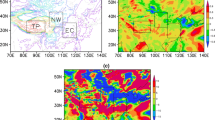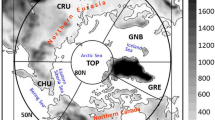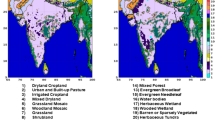Abstract
A standalone Advanced Circulation (ADCIRC) model for the east coast of India with a high-resolution grid of 100 m near the coast is used to evaluate coastal inundation resulting from the storm tides generated by recent cyclones. A directional surface roughness parametrization that alters wind speed and Manning’s n friction coefficient to compute bottom friction based on land use/land cover (LULC) at a particular location is incorporated in the model. ERA5 reanalysis winds highlight that the cyclonic winds over the land are less intensive than nearby coastal oceans, particularly during landfall time, by approximately 29%–50%. Experiments are also designed to quantify the impact of surface and bottom friction on wind speed and the inward propagation of storm tides. A comparison of cyclonic wind speed after incorporating LULC data in the model is made with an automatic surface observation system (ASOS). It suggests a 15%–29% reduction, consistent with ASOS. The inundated area computed for the cyclones advocates a significant reduction (15%–50%) due to LULC. Sensitivity experiments with LULC are performed to examine the impact of mangroves in the Krishna estuary located in between two concave-shaped coastal geometries. Replacing wetlands with Mangroves results in a simultaneous decline in wind speed (12.5%) and inundated area (13.4%). It also highlights that bottom friction contributes (9.4%) in the inundated area against surface friction (4%). This study infers that further investigation and planning are mandatory to ensure coastal mangrove restoration initiatives and effective coastal management practices.












Similar content being viewed by others
References
Bunya S, Dietrich JC, Westerink JJ, Ebersole BA, Smith JM, Atkinson JH, Jensen R, Resio DT, Luettich RA, Dawson C, Cardone VJ, Cox AT, Powell MD, Westerink HJ, Roberts HJ (2010) A high-resolution coupled river line flow, tide, wind, wind wave, and storm surge model for southern Louisiana and Mississippi. Part I: model development and validation. Mon Weather Rev 138:345–377
Das PK (1972) Prediction model for storm surges in the Bay of Bengal. Nature 239(5369):211–213
Dube SK, Rao AD, Sinha PC, Chittibabu P (1994) A real-time storm surge prediction system: an application to the east coast of India. Proc Ind Natl Sci Acad Part A 60:157–157
Friedl MA, Sulla-Menashe D, Tan B, Schneider A, Ramankutty N, Sibley A, Huang X (2010) MODIS Collection 5 global land cover: algorithm refinements and characterization of new datasets. Remote Sens. Environ. 114(1):168–182. https://appeears.earthdatacloud.nasa.gov
Hersbach H, Bell B, Berrisford P, Hirahara S, Horányi A, Muñoz‐Sabater J et al (2020) The ERA5 global reanalysis. Q J Roy Meteorol Soc 146(730): 1999–2049. https://cds.climate.copernicus.eu/cdsapp#!/dataset/reanalysis-era5singlelevels?tab=form
Holland GJ (1980) An analytic model of the wind and pressure profiles in hurricanes. Mon Weather Rev 108:1212–1218
Holland GJ, James BI, Fritz A (2010) A revised model for radial profiles of hurricane winds. Am Meteorol Soc. https://doi.org/10.1175/2010MWR3317.1
Hu K, Chen Q, Wang H (2015) A numerical study of vegetation impact on reducing storm surge by wetlands in a semi-enclosed estuary. Coast Eng 95:66–76. https://doi.org/10.1016/j.coastaleng.2014.09.008
Iowa Environmental Mesonet (2018) ASOS network. https://mesonet.agron.iastate.edu/request/download.phtml?network=AZ_ASOS
Johns B, Sinha PC, Dube SK, Mohanty UC, Rao AD (1983) On the effect of bathymetry in numerical storm surge simulation experiments. Comput Fluids 11(3):161–174
Kolar RL, Gray WG, Westerink JJ, Luettich RA (1994) Shallow water modeling in spherical coordinates: equation formulation, numerical implementation, and application. J Hydraul Res 32:3–24
Kolukula SS, Murty PLN (2022) Improving cyclone wind fields using deep convolutional neural networks and their application in extreme events. Prog Oceanogr. https://doi.org/10.1016/j.pocean.2022.102763
Le Provost C, Lyard F, Molines JM, Genco ML, Rabilloud F (1998) A hydrodynamic ocean tide model improved by assimilating a satellite altimeter-derived data set. J Geophys Res Oceans 103(C3):5513–5529
Luettich RA, Westerink JJ, Scheffner NW (1992) ADCIRC: an advanced three-dimensional circulation model for shelves, coasts, and estuaries. Report 1: theory and methodology of ADCIRC-2DDI and ADCIRC-3DL. Dredging Research Program technical report DRP-92-6. US Army Engineers Waterways Experiment Station, Vicksburg, Mississippi
Luettich RA, Westerink JJ, Scheffner NW (1992) ADCIRC: an advanced three-dimensional circulation model for shelves, coasts, and estuaries. Report 1, Theory and methodology of ADCIRC-2DD1 and ADCIRC-3DL
Machineni N, Sinha VSP, Singh P, Reddy NT (2019) The impact of distributed land use information in hydrodynamic model application in storm surge inundation. Estuar Coast Shelf Sci 231:106466
Mandal AK, Ramakrishnan R, Pandey S, Rao AD, Kumar P (2020) An early warning system for inundation forecast due to a tropical cyclone along the east coast of India. Nat Hazards 103:2277–2293. https://doi.org/10.1007/s11069-020-04082-w
Mattocks C, Forbes C (2008) A real-time, event-triggered storm surge forecasting system for the state of North Carolina. Ocean Model 25(3–4):95–119. https://doi.org/10.1016/j.ocemod.2008.06.008
Medeiros SC, Hagen SC, Weishampel JF (2012) Comparison of floodplain surface roughness parameters derived from land cover data and field measurements. J Hydrol 452:139–149
Murty PLN, Kolukula SS (2023) Future projections of storm surges and associated coastal inundation along the east coast of India. J Water Clim Change 14(5):1413–1432. https://doi.org/10.2166/wcc.2023.358
Murty PLN, Bhaskaran PK, Gayathri R, Sahoo B, Srinivasa Kumar T, SubbaReddy B (2016) Numerical study of coastal hydrodynamics using a coupled model for Hudhud cyclone in the Bay of Bengal. Estuar Coast Shelf Sci 183:13–27. https://doi.org/10.1016/j.ecss.2016.10.013
Murty PLN, Rao AD, Srinivas KS et al (2020a) Effect of wave radiation stress in storm surge-induced inundation: a case study for the east coast of India. Pure Appl Geophys 177:2993–3012. https://doi.org/10.1007/s00024-019-02379-x
Murty PLN, Srinivas KS, Rao EPR, Bhaskaran PK, Shenoi SSC, Padmanabham J (2020b) Improved cyclonic wind fields over the Bay of Bengal and their application in storm surge and wave computations. Appl Ocean Res 95:102048. https://doi.org/10.1016/j.apor.2019.102048
Pandey S, Rao AD (2018) An improved cyclonic wind distribution for computation of storm surges. Nat Hazards 92:93–112. https://doi.org/10.1007/s11069-018-3193-3
Pandey S, Rao AD (2019) Impact of approach angle of an impinging cyclone on generation of storm surges and its interaction with tides and wind waves. J Geophys Res Oceans 124:7643–7660
Pandey S, Rao AD, Raktim H (2021) Modeling of coastal inundation in response to a tropical cyclone using a coupled hydraulic HEC-RAS and ADCIRC model. J Geophys Res Oceans 126:e2020JC016810. https://doi.org/10.1029/2020JC016810
Powell M, Houston S, Reinhold T (1996) Hurricane Andrew’s landfall in south Florida. Part I: standardizing measurements for documentation of surface wind fields. Wea Forecasting 11:304–328
Powell M, Houston S, Amat L, Morrisseau-Leroy N (1998) The HRD real-time hurricane wind analysis system. J Wind Eng Indust Aerodyn 77–78:53–64
Rao YR, Chittibabu P, Dube SK, Rao AD, Sinha PC (1997) Storm surge prediction and frequency analysis for Andhra coast of India. Mausam 48:555–566. https://doi.org/10.54302/mausam.v48i4.4322
Rezaie AM, Ferreira CM, Walls M, Chu Z (2021) Quantifying the impacts of storm surge, sea level rise, and potential reduction and changes in wetlands in coastal areas of the Chesapeake Bay region. Nat Hazards Rev 22(4). https://doi.org/10.1061/(ASCE)NH.1527-6996.0000505
RSMC Report (2011) http://www.rsmcnewdelhi.imd.gov.in/images/pdf/archive/rsmc/2011.pdf
RSMC Report (2018) http://www.rsmcnewdelhi.imd.gov.in/images/pdf/archive/rsmc/2018.pdf
RSMC Report (2019) http://www.rsmcnewdelhi.imd.gov.in/images/pdf/archive/rsmc/2019.pdf
Sheng YP, Zhang Y, Paramygin VA (2010) Simulation of storm surge, wave, and coastal inundation in the Northeastern Gulf of Mexico region during Hurricane Ivan in 2004. Ocean Model 35:314–331. https://doi.org/10.1016/j.ocemod.2010.09.004
Wamsley TV, Cialone MA, Smith JM, Ebersole BA, Grzegorzewski AS (2009) Influence of landscape restoration and degradation on storm surge and waves in southern Louisiana. Nat Hazards 51(1):207–224. https://doi.org/10.1007/s11069-009-9378-z
Westerink JJ, Luettich RA, Baptista AM, Scheffner NW, Farrar P, Muccino JC (1994) Modeling tides in the western North Atlantic using unstructured graded grids. Tellus 46A:178–199
Westerink JJ, Luettich RA, Feyen JC, Atkinson JH, Dawson C, Roberts HJ, Powell MD, Dunion JP, Kubatko EJ, Pourtaheri H (2008) A basin-to channel-scale unstructured grid hurricane storm surge model applied to southern Louisiana. Mon Weather Rev 136:833–864. https://doi.org/10.17615/dq0t-xa11
Yin K, Xu SD, Zhao Q, Huang WR, Yang K, Guo MT (2020) Effects of land cover change on atmospheric and storm surge modeling during typhoon event. Ocean Eng 199:106971. https://doi.org/10.1016/j.oceaneng.2020.106971
Yoon JJ, Shim JS, Park KS, Lee JC (2014) Numerical experiments of storm winds, surges, and waves on the southern coast of Korea during Typhoon Sanba: the role of revising wind force. Nat Hazards Earth Sys Sci 14(12):3279–3295. https://doi.org/10.5194/nhess-14-3279-2014
Zhang K et al (2012) The role of mangroves in attenuating storm surges. Estuary Coast Shelf Sci 102:11–23. https://doi.org/10.1016/j.ecss.2012.02.021
Acknowledgements
The authors sincerely acknowledge the Indian Space Research Organization (ISRO) for providing financial support to carry out this study through a project sanctioned under IIT Delhi Space Technology Cell (STC) in collaboration with the Space Applications Centre, Ahmedabad. The authors also thank IIT Delhi HPC facility for affording computational resources.
Author information
Authors and Affiliations
Contributions
Pawan Tiwari: Conceptualization, Formal analysis, Investigation, Methodology, Software, Validation, Visualization, Writing – original draft, Writing – review & editing. A D Rao: Conceptualization, Methodology, Supervision, Visualization, Writing – review & editing. Smita Pandey: Methodology, Visualization, Writing – review & editing. Vimlesh Pant: Writing – review & editing.
Corresponding author
Ethics declarations
Conflict of interest
The authors declare that they have no known competing financial interests or personal relationships that could have appeared to influence the work reported in this paper.
Additional information
Publisher's Note
Springer Nature remains neutral with regard to jurisdictional claims in published maps and institutional affiliations.
Rights and permissions
Springer Nature or its licensor (e.g. a society or other partner) holds exclusive rights to this article under a publishing agreement with the author(s) or other rightsholder(s); author self-archiving of the accepted manuscript version of this article is solely governed by the terms of such publishing agreement and applicable law.
About this article
Cite this article
Tiwari, P., Rao, A.D., Pandey, S. et al. Assessing the influence of land use and land cover data on cyclonic winds and coastal inundation due to tropical cyclones: a case study for the east coast of India. Nat Hazards (2024). https://doi.org/10.1007/s11069-024-06603-3
Received:
Accepted:
Published:
DOI: https://doi.org/10.1007/s11069-024-06603-3




